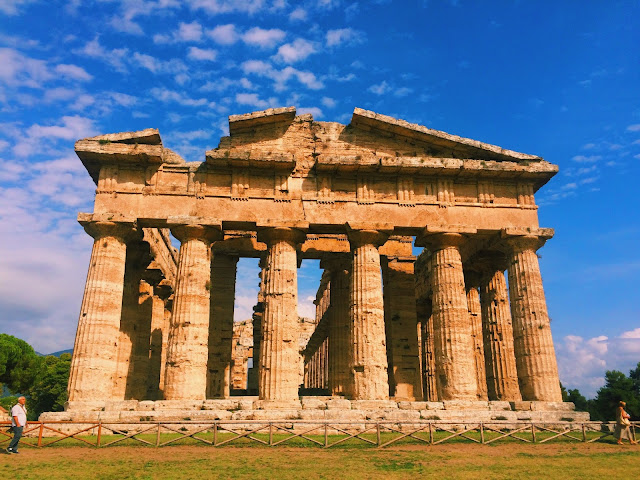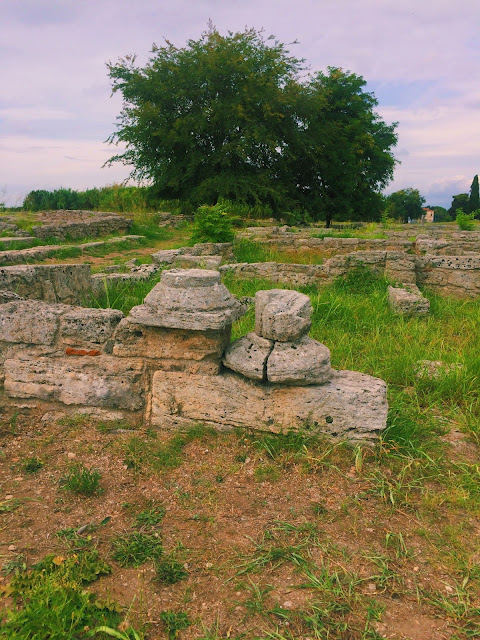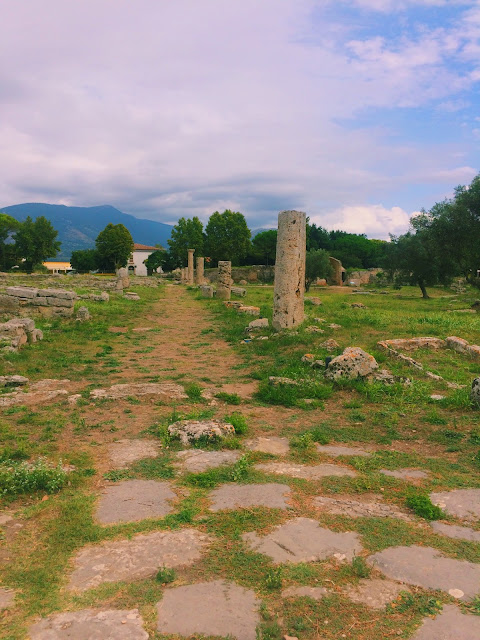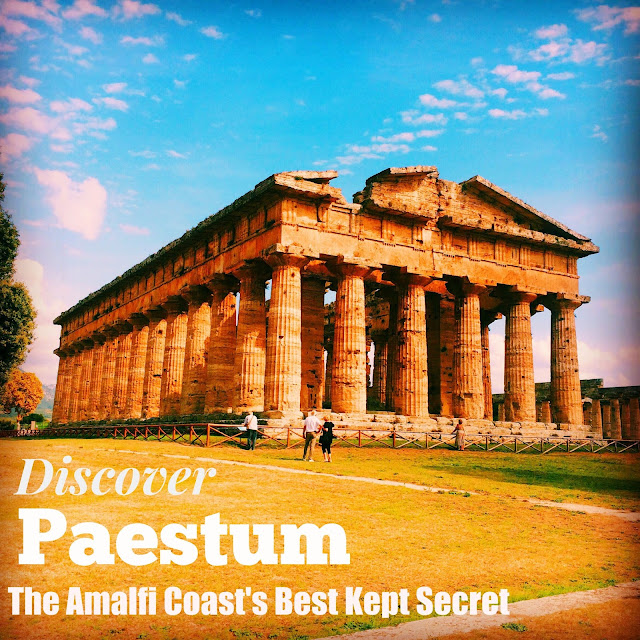One of the (many) things that keeps me coming back to Italy the never ending supply of historical surprises waiting around each and every corner.
Everyone knows about the Colosseum, the Leaning Tower of Pisa, the Grand Canal in Venice. I love all the big, well known postcard famous sights, and will always go back to them, but I find pure magic in the lesser known, less visited 'secret' places that I stumble upon every time I'm there.
This year I took my Corinna B's World Glam Italia Tour to several of my secret Italian places, one of which was the magnificent Paestum, located an hour south of Salerno, south of the Amalfi Coast.
Paestum is the Roman name for a small, ancient Greek city in Campania, formerly known as Poseidonia (back when southern Italy was known as Magna Grecia in the 8th thru 5th centuries BC).
Paestum is the home of 3 of the best preserved Greek temples in the world. (The other 8 best preserved Greek temples are not found in Greece, but in Sicily's Valley of the Temples, near Agrigento.)
The experience of visiting Paestum is just staggering.
In the middle of nowhere, as you drive through the countryside past farms that make bufalo mozzarella, suddenly these three giant temples rise up majestically out of the landscape, completely taking your breath away.
They are huge. They are magnificent. They are ancient. And they are unspoiled.
Built 2500 - 2600 years ago, before even the Parthenon, this is really ancient Greek. The scale of these temples, the force with which they rise up out of the earth and the absolute beauty of them just leaves you at a loss for words.
Goethe said it was like a strike of lightening hitting his mind.
You really feel like you are standing in a vanished, ancient city.
Paestum is a little remote, and unlike Pompeii which is surrounded by shops and vendors and tourism as well as neighborhoods where locals live, here there is almost nothing. And no one. Just you, the breeze coming off the ocean and a mere handful of other tourists.
The Greeks were always in search of perfection and ideal beauty, and they liked to build their temples and ampitheaters with beauty in mind and with gorgeous views, especially over water.
Grouped closely together, the first temple is Hera I, built for the goddess of fertility and wife of Zeus, circa 550 BC.
Hera I is also known as The Basilica. has perfect geometric doubling with 9 columns at each end and 18 along each side, giving it a very horizontal feel. It has massive heavy columns that have no feet, instead rising up from the stylobate and ending in a simple geometric capital. To support the weight of the roof the columns bulge in the middle and taper at the top.
It was built from local stone and then stucco'd, but the stucco is long since gone. This temple is massive, yet in spite of it's size retains a gracious femininity and equanimity.
The middle temple is known as Hera II, and was built circa 460 BC.
With 6 columns along each end and 14 columns along each side, Hera II feels like an exercise in perfect balance. Standing beside Hera I she by comparison feels very vertical and slender. The 6 column figuration in front means you can walk through the middle, making her feel more symmetrical.
It is thought that Hera II would have had a terracotta roof, and she appears to have had a second story, or perhaps some form of platform that sat over top of the ground floor.
Both Hera I and Hera II face the ocean. You can imagine how magnificent they must have looked standing side by side, gleaming white in the hot Campania sunshine as they watched over the blue sea from the front and the fertile pastureland from the back.
The Temple of Athena, also known as the temple of Ceres, built in 500 BC. This is actually the first temple you see as you drive into town. It sits a little higher and away from the other two temples, which stand side by side.
Interestingly this temple has Doric columns on the outside and Ionic columns on the inside.
In front of the temple is an alter where sacrifices took place.
Greek temples were houses to the Gods, where statues were stored. Ceremonies and worship took place at the alter outside of the temple.
In Paestum Hera was not only the Goddess of fertility, but also of childbirth.
An elaborate pool was built for Hera where women who were trying to conceive could bathe and sit, but also where women would come to ask Hera for an easy childbirth.
When the Romans took over the area in the 3rd century BC they didn't destroy the temples, and they didn't just move down the road a ways to build their new city out of sight of them, instead they renamed Poseidonia to Paestum and built a city around it's temples.
This adds another layer of magic, as you can walk through the wide streets of this roman town and into apartment complexes that border the temples.
Who knew that the Romans built apartment buildings? I didn't.
There are still mosaic floors intact, and enough of the structure of the ruins remain so that you can figure out where the front door was, what the view was, where the various rooms were positioned.
There is a small museum opposite the temples, where you can see the oldest surviving wall paintings from ancient Greece, which makes them also the oldest surviving wall paintings in all of western art.
In 1968 the excavation of a tomb in Paestum unearthed paintings dated to around 480 BC.
This ancient Greek world was a homo-erotic world. If you were going to be in love it would be with another man. Men were for love, women were for procreation.
Paestum is one of the most spectacular places I have ever been.
And it's one of those treasures that no one seems to know about. We were there on a free Sunday, and I had been worried that it would be overflowing with tourists taking advantage of the zero ticket price, but in all the hours that we were there exploring there would not have even been 100 people total. Probably not even 50. It felt as though we had this giant, spectacular slice of history all to ourselves.
If you do take the time to visit Paestum I definitely recommend visiting Pompeii first, as it will give you a fantastic understanding of how Roman homes were laid out, and this will add another dimension to the already incredible Paestum experience.
If you are staying on the Amalfi Coast it is well worth giving up a half day or a day and taking the train to Paestum. It's a long drive from Positano or Sorrento, but by car from Salerno it only takes one hour.
I am amazed that there is such a mad tourist crush in nearby Capri, sometimes you can barely walk down the street in Positano there are so many people, and yet there is virtually no one visiting Paestum.
Paestum is not actually on the Amalfi Coast, but for most people traveling in the region, the Amalfi Coast is the closest geographical reference that they will be familiar with.
All photos taken with my iPhone remain my property. Please do not re-use without my written permission.
Everyone knows about the Colosseum, the Leaning Tower of Pisa, the Grand Canal in Venice. I love all the big, well known postcard famous sights, and will always go back to them, but I find pure magic in the lesser known, less visited 'secret' places that I stumble upon every time I'm there.
This year I took my Corinna B's World Glam Italia Tour to several of my secret Italian places, one of which was the magnificent Paestum, located an hour south of Salerno, south of the Amalfi Coast.
Paestum is the Roman name for a small, ancient Greek city in Campania, formerly known as Poseidonia (back when southern Italy was known as Magna Grecia in the 8th thru 5th centuries BC).
 |
| Temple Hera II, Paestum |
Paestum is the home of 3 of the best preserved Greek temples in the world. (The other 8 best preserved Greek temples are not found in Greece, but in Sicily's Valley of the Temples, near Agrigento.)
The experience of visiting Paestum is just staggering.
In the middle of nowhere, as you drive through the countryside past farms that make bufalo mozzarella, suddenly these three giant temples rise up majestically out of the landscape, completely taking your breath away.
 |
| Hera I, Paestum |
They are huge. They are magnificent. They are ancient. And they are unspoiled.
Built 2500 - 2600 years ago, before even the Parthenon, this is really ancient Greek. The scale of these temples, the force with which they rise up out of the earth and the absolute beauty of them just leaves you at a loss for words.
Goethe said it was like a strike of lightening hitting his mind.
 |
| Roman road built circa 300 BC, with roman apartment buildings on the right, and temples on the left |
You really feel like you are standing in a vanished, ancient city.
 |
| remains of Roman apartment buildings in Paestum |
Paestum is a little remote, and unlike Pompeii which is surrounded by shops and vendors and tourism as well as neighborhoods where locals live, here there is almost nothing. And no one. Just you, the breeze coming off the ocean and a mere handful of other tourists.
The Greeks were always in search of perfection and ideal beauty, and they liked to build their temples and ampitheaters with beauty in mind and with gorgeous views, especially over water.
Grouped closely together, the first temple is Hera I, built for the goddess of fertility and wife of Zeus, circa 550 BC.
Hera I is also known as The Basilica. has perfect geometric doubling with 9 columns at each end and 18 along each side, giving it a very horizontal feel. It has massive heavy columns that have no feet, instead rising up from the stylobate and ending in a simple geometric capital. To support the weight of the roof the columns bulge in the middle and taper at the top.
 |
| Hera I, The Basilica, Paestum |
It was built from local stone and then stucco'd, but the stucco is long since gone. This temple is massive, yet in spite of it's size retains a gracious femininity and equanimity.
 |
| Hera I, Paestum |
The middle temple is known as Hera II, and was built circa 460 BC.
With 6 columns along each end and 14 columns along each side, Hera II feels like an exercise in perfect balance. Standing beside Hera I she by comparison feels very vertical and slender. The 6 column figuration in front means you can walk through the middle, making her feel more symmetrical.
 |
| Hera II, Paestum |
It is thought that Hera II would have had a terracotta roof, and she appears to have had a second story, or perhaps some form of platform that sat over top of the ground floor.
Both Hera I and Hera II face the ocean. You can imagine how magnificent they must have looked standing side by side, gleaming white in the hot Campania sunshine as they watched over the blue sea from the front and the fertile pastureland from the back.
 |
| inside Hera II |
The Temple of Athena, also known as the temple of Ceres, built in 500 BC. This is actually the first temple you see as you drive into town. It sits a little higher and away from the other two temples, which stand side by side.
 |
| Ceres/Athena Temple in Paestum |
Interestingly this temple has Doric columns on the outside and Ionic columns on the inside.
In front of the temple is an alter where sacrifices took place.
Greek temples were houses to the Gods, where statues were stored. Ceremonies and worship took place at the alter outside of the temple.
In Paestum Hera was not only the Goddess of fertility, but also of childbirth.
 |
| Hera's fertility pool, Paestum |
An elaborate pool was built for Hera where women who were trying to conceive could bathe and sit, but also where women would come to ask Hera for an easy childbirth.
When the Romans took over the area in the 3rd century BC they didn't destroy the temples, and they didn't just move down the road a ways to build their new city out of sight of them, instead they renamed Poseidonia to Paestum and built a city around it's temples.
 |
| ancient Roman roads in the city of Paestum, beside the temples |
This adds another layer of magic, as you can walk through the wide streets of this roman town and into apartment complexes that border the temples.
 |
| mosaic floors more than 2300 years old, in Roman apartments in Paestum |
Who knew that the Romans built apartment buildings? I didn't.
There are still mosaic floors intact, and enough of the structure of the ruins remain so that you can figure out where the front door was, what the view was, where the various rooms were positioned.
 |
| mosaic floors at the entryway to a Roman apartment, circa 300 BC |
 |
| inside another Roman apartment |
There is a small museum opposite the temples, where you can see the oldest surviving wall paintings from ancient Greece, which makes them also the oldest surviving wall paintings in all of western art.
In 1968 the excavation of a tomb in Paestum unearthed paintings dated to around 480 BC.
 |
| art was a celebration of the love amongst men |
This ancient Greek world was a homo-erotic world. If you were going to be in love it would be with another man. Men were for love, women were for procreation.
 |
| the ceiling of the tomb |
Paestum is one of the most spectacular places I have ever been.
And it's one of those treasures that no one seems to know about. We were there on a free Sunday, and I had been worried that it would be overflowing with tourists taking advantage of the zero ticket price, but in all the hours that we were there exploring there would not have even been 100 people total. Probably not even 50. It felt as though we had this giant, spectacular slice of history all to ourselves.
If you do take the time to visit Paestum I definitely recommend visiting Pompeii first, as it will give you a fantastic understanding of how Roman homes were laid out, and this will add another dimension to the already incredible Paestum experience.
If you are staying on the Amalfi Coast it is well worth giving up a half day or a day and taking the train to Paestum. It's a long drive from Positano or Sorrento, but by car from Salerno it only takes one hour.
I am amazed that there is such a mad tourist crush in nearby Capri, sometimes you can barely walk down the street in Positano there are so many people, and yet there is virtually no one visiting Paestum.
Paestum is not actually on the Amalfi Coast, but for most people traveling in the region, the Amalfi Coast is the closest geographical reference that they will be familiar with.
All photos taken with my iPhone remain my property. Please do not re-use without my written permission.

